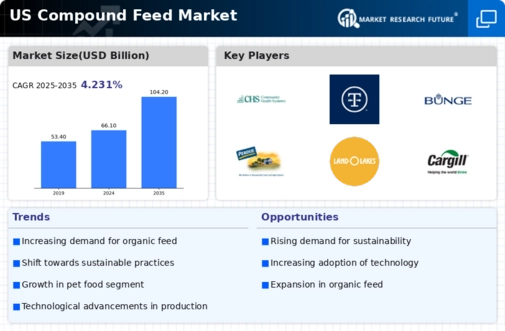Growth of the Pet Food Sector
The pet food sector is experiencing rapid growth, which is positively impacting the compound feed market. As pet ownership rises in the US, the demand for high-quality pet food is increasing, leading to a surge in the production of specialized feeds. The compound feed market is adapting to this trend by developing formulations that cater to the nutritional needs of pets, including premium and organic options. This segment is projected to grow at a CAGR of over 5% in the coming years, indicating a robust opportunity for feed manufacturers. The expansion of the pet food market is likely to drive innovation and diversification within the compound feed market.
Rising Demand for Animal Protein
The increasing demand for animal protein in the US is a primary driver of the compound feed market. As consumer preferences shift towards protein-rich diets, the livestock sector is experiencing heightened pressure to produce more meat, dairy, and eggs. This trend is reflected in the projected growth of the compound feed market, which is expected to reach approximately $60 billion by 2026. The compound feed market is responding to this demand by optimizing feed formulations to enhance growth rates and feed efficiency. Additionally, the rise of alternative protein sources, such as plant-based proteins, may influence traditional livestock feed formulations, prompting innovation within the compound feed market.
Regulatory Support for Feed Quality
Regulatory frameworks in the US are increasingly emphasizing the quality and safety of animal feed, which significantly impacts the compound feed market. The Food and Drug Administration (FDA) and the Association of American Feed Control Officials (AAFCO) have established guidelines that ensure the nutritional adequacy and safety of feed products. Compliance with these regulations is crucial for manufacturers, as it not only affects market access but also consumer trust. The compound feed market is likely to see a rise in demand for certified and high-quality feed products, as producers seek to meet both regulatory standards and consumer expectations for safe animal products.
Consumer Awareness of Animal Welfare
Consumer awareness regarding animal welfare is increasingly influencing the compound feed market. As consumers become more informed about farming practices, there is a growing demand for products that align with ethical standards. This trend is prompting livestock producers to adopt more humane practices, which in turn affects feed formulations. The compound feed market is likely to see a rise in demand for feeds that support animal health and welfare, as producers seek to enhance their marketability. This shift may also lead to the development of specialized feeds that cater to the needs of animals raised under higher welfare standards.
Technological Advancements in Feed Production
Technological advancements are reshaping the compound feed market, enhancing production efficiency and product quality. Innovations such as precision nutrition, automated feed manufacturing, and data analytics are being adopted to optimize feed formulations and reduce waste. The compound feed market is witnessing a shift towards more sophisticated production techniques, which can lead to cost savings and improved feed conversion ratios. As these technologies become more accessible, smaller producers may also benefit, potentially increasing competition within the market. The integration of technology in feed production is expected to drive growth and innovation in the compound feed market.


















Leave a Comment